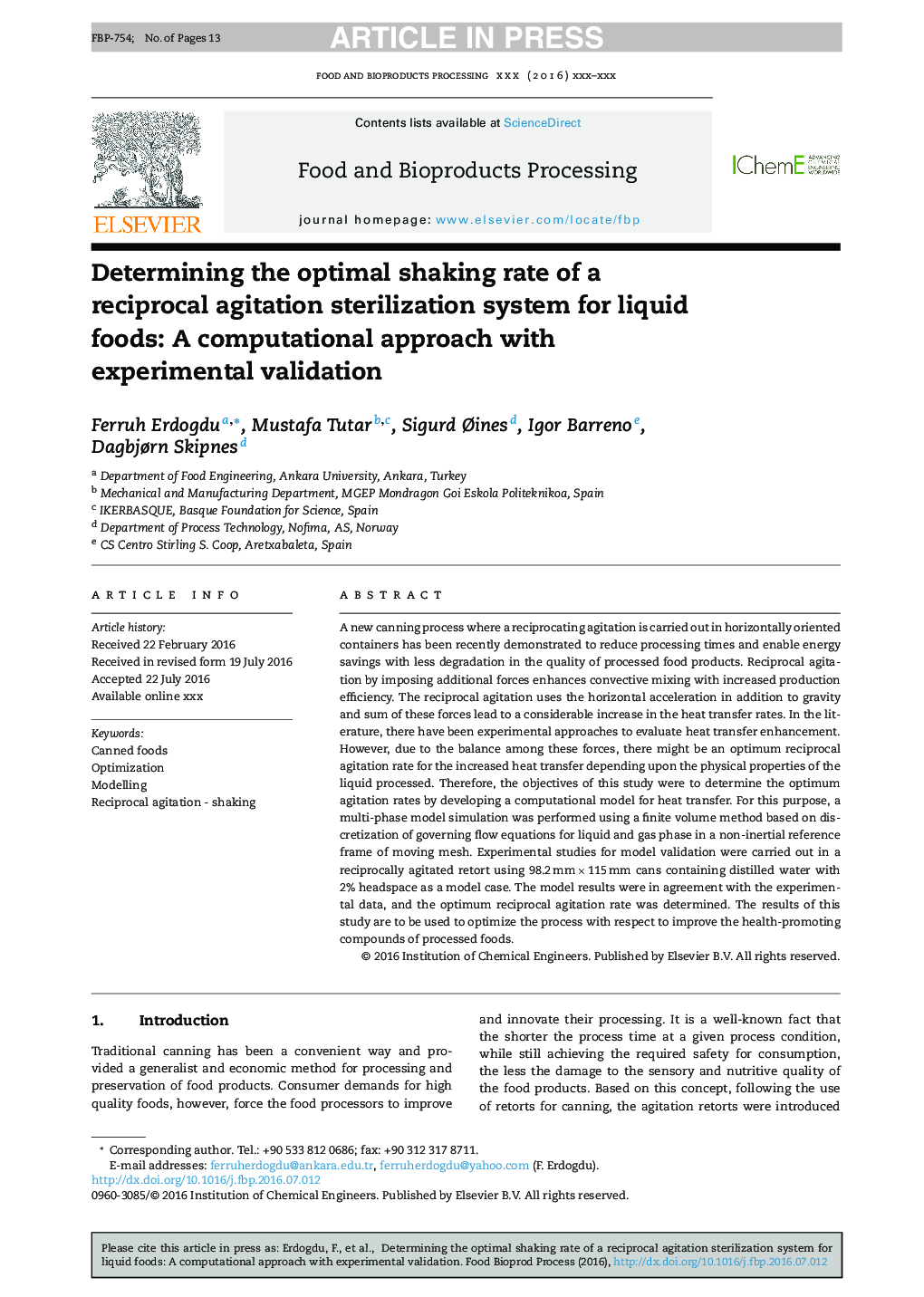| کد مقاله | کد نشریه | سال انتشار | مقاله انگلیسی | نسخه تمام متن |
|---|---|---|---|---|
| 6488429 | 43033 | 2016 | 13 صفحه PDF | دانلود رایگان |
عنوان انگلیسی مقاله ISI
Determining the optimal shaking rate of a reciprocal agitation sterilization system for liquid foods: A computational approach with experimental validation
ترجمه فارسی عنوان
تعیین میزان تکان دادن مطلوب یک سیستم ضدعفونی متقاطع برای مواد غذایی مایع: یک روش محاسباتی با اعتبار سنجی آزمایشی
دانلود مقاله + سفارش ترجمه
دانلود مقاله ISI انگلیسی
رایگان برای ایرانیان
کلمات کلیدی
مواد غذایی کنسرو شده، بهینه سازی، مدل سازی، آشفتگی متقابل - تکان دادن،
ترجمه چکیده
یک فرایند تهیه کنسروی جدید که در آن ظهور متقابل در کانتینرهای افقی صورت گرفته است، به تازگی نشان داده شده است تا زمانهای پردازش را کاهش داده و با صرفه جویی کمتر در کیفیت محصولات غذایی فرآوری شده، صرفه جویی در انرژی را افزایش دهد. تحرک متقابل با اعمال نیروهای اضافی باعث افزایش مخلوط کنسانتره با افزایش بهره وری تولید می شود. تحریک متقابل از شتاب افقی به علاوه گرانش استفاده می کند و مجموع این نیروها منجر به افزایش چشمگیر میزان انتقال حرارت می شود. در ادبیات، روشهای آزمایشی برای ارزیابی انتقال حرارت وجود دارد. با این حال، با توجه به تعادل بین این نیروها، ممکن است یک نرخ آستانه متقابل بهینه برای افزایش انتقال حرارت، بسته به خواص فیزیکی مایع پردازش شده، وجود داشته باشد. بنابراین هدف از این مطالعه تعیین میزان آستانه بهینه با ایجاد یک مدل محاسباتی برای انتقال حرارت است. برای این منظور یک شبیه سازی مدل چند مرحلهای با استفاده از روش حجم محدود بر مبنای تقسیم معادلات جریان حاکم برای فاز مایع و گاز در یک سیستم مرجع غیرایرانی جابجایی مش انجام شد. مطالعات تجربی برای اعتبارسنجی مدل با استفاده از یک رتور متقاطع با استفاده از یک ورقه ورقه ای با ضخامت 2. نتایج مدل با داده های تجربی هماهنگ شده و میزان آرام سازی متقابل مطلوب تعیین شده است. نتایج این مطالعه به منظور بهینه سازی روند با توجه به بهبود ترکیبات ارتقا دهنده سلامت مواد غذایی فرآوری شده مورد استفاده قرار می گیرد.
موضوعات مرتبط
مهندسی و علوم پایه
مهندسی شیمی
بیو مهندسی (مهندسی زیستی)
چکیده انگلیسی
A new canning process where a reciprocating agitation is carried out in horizontally oriented containers has been recently demonstrated to reduce processing times and enable energy savings with less degradation in the quality of processed food products. Reciprocal agitation by imposing additional forces enhances convective mixing with increased production efficiency. The reciprocal agitation uses the horizontal acceleration in addition to gravity and sum of these forces lead to a considerable increase in the heat transfer rates. In the literature, there have been experimental approaches to evaluate heat transfer enhancement. However, due to the balance among these forces, there might be an optimum reciprocal agitation rate for the increased heat transfer depending upon the physical properties of the liquid processed. Therefore, the objectives of this study were to determine the optimum agitation rates by developing a computational model for heat transfer. For this purpose, a multi-phase model simulation was performed using a finite volume method based on discretization of governing flow equations for liquid and gas phase in a non-inertial reference frame of moving mesh. Experimental studies for model validation were carried out in a reciprocally agitated retort using 98.2 mm Ã 115 mm cans containing distilled water with 2% headspace as a model case. The model results were in agreement with the experimental data, and the optimum reciprocal agitation rate was determined. The results of this study are to be used to optimize the process with respect to improve the health-promoting compounds of processed foods.
ناشر
Database: Elsevier - ScienceDirect (ساینس دایرکت)
Journal: Food and Bioproducts Processing - Volume 100, Part B, October 2016, Pages 512-524
Journal: Food and Bioproducts Processing - Volume 100, Part B, October 2016, Pages 512-524
نویسندگان
Ferruh Erdogdu, Mustafa Tutar, Sigurd Ãines, Igor Barreno, Dagbjørn Skipnes,
